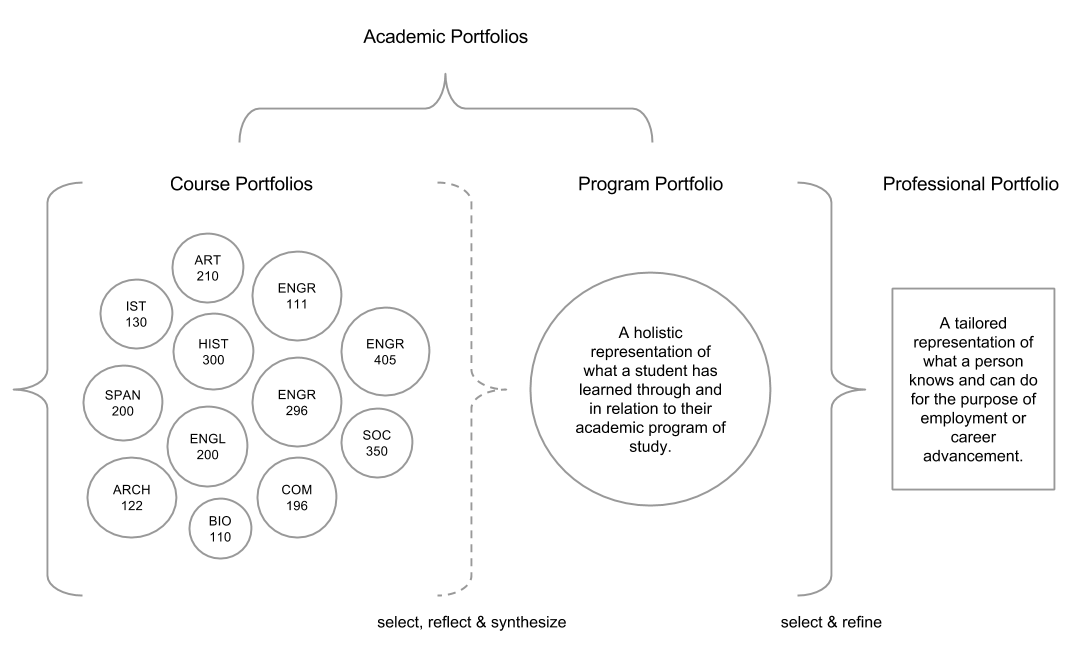Best Practices: Students
Purpose and Audience
Portfolios can serve different purposes. Think about the following questions:
- Why are you creating a portfolio?
- How will the portfolio help you accomplish your objective(s)?
- Who is the intended audience of your portfolio?
Your audience can include one or more of the following:
- Self
- Peers
- Instructors
- Class (e.g. peers and instructors)
- Credentialing authorities (e.g. the University, professional organizations)
- Prospective employers
- Interest groups
- General public
Make sure the purpose of your portfolio is clearly conveyed to your audience.
Recommended resource:
- Copyblogger – Helps you build a better portfolio with advice on blogging, social media, multimedia, and marketing.
Evidence, Reflection, and Assessment
Evidence
One of the benefits of web publishing is that it supports multimodal learning and multimedia expression. You can use portfolios to show evidence of your learning through a variety of media, such as text, image, and video.
- What types of media are you interested in using?
- What types of media are used in the field of work you want to do after graduation?
- Consider using different types of media in your portfolio to make it more interesting to viewers and to demonstrate your creative and technical skills.
Find publicly available portfolios (or websites of similar style) that you would like to model your own portfolio after.
- Do you want to replicate the communication styles of a particular profession or practice? If so, look at portfolios (or websites of similar style) determined to be outstanding within that field.
- Do you want your portfolio to be your own self-determined space? If so, then look at a wide variety of examples that illustrate different design possibilities.
- When looking at portfolios (of websites of similar style) for inspiration, think about why you chose them. What do you like about the layout or organizational structure, the colors, the font styles, the tone of language used, or the amount of content (e.g. text, images, video) on the pages?
- List the specific design qualities of the examples that interest you and think about how you might incorporate those qualities into your portfolio.
Recommended resources:
- Web Style Guide
- Penn State’s MediaCommons
Reflection
Reflection is a key component of an academic portfolio. It allows you to build a history of thought around a particular topic and helps you to think more deeply about what, why, and how you learn.
Posting a completed assignment to a portfolio as evidence of learning is not enough. An academic portfolio requires reflection!
Assessment
Assessment is another key component of an academic portfolio. Students should ask for and include meaningful feedback on their work in their portfolio. Meaningful feedback helps students learn better than grades alone and provides evidence of what others think about the quality of work in the portfolio.
Feedback can come from a variety of sources, including instructors, peers, mentors, internship supervisors, coaches, credentialing authorities, and members of professional organizations.
Types of Portfolios
Academic portfolios should always include evidence of what you have learned, and your reflections on your learning experiences, as well as some form of assessment that others have made about your work.
Over time you may have created several different course portfolios. If you want to showcase some of the work you have done but don’t want to share each portfolio, you can select specific examples to synthesize in a program portfolio.
Before graduation, or when preparing to look for a job or internship, you should create a professional portfolio that you can share publicly. A professional portfolio should represent only the best, or most relevant, work in your academic portfolio.
The following graphic illustrates how these types of portfolios relate to one another.

Summary
Create your portfolio with purpose and use it often over time. If you are creating a portfolio for a course, begin using it as soon as possible so that it becomes a space for learning rather than an afterthought.
When creating your portfolio, either for your own reasons or as a class assignment, make sure to allow for the time it may take you to:
- Define the purpose of your portfolio.
- Learn how to use a web publishing platform.
- Design your portfolio.
- Upload files, such as assignments, to your portfolio.
- Keep the content and appearance of your portfolio current.
- Synthesize and reflect upon the learning experiences documented in your portfolio.
- Seek and receive feedback on your work from your instructors and peers.
